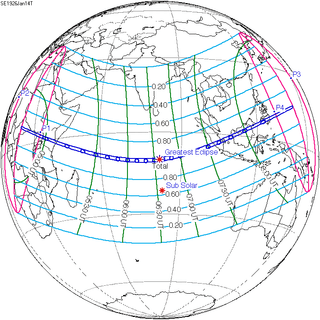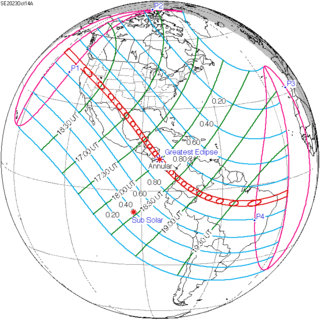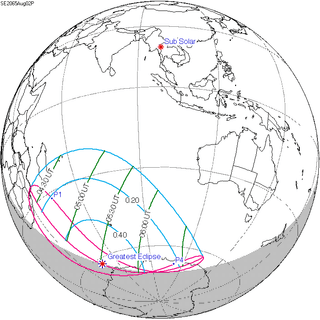Solar eclipse of March 9, 2016
| Solar eclipse of March 9, 2016 | |
|---|---|
|
| |
 Map | |
| Type of eclipse | |
| Nature | Total |
| Gamma | 0.2609 |
| Magnitude | 1.045 |
| Maximum eclipse | |
| Duration | 249 sec (4 m 9 s) |
| Coordinates | 10°06′N 148°48′E / 10.1°N 148.8°E |
| Max. width of band | 155 km (96 mi) |
| Times (UTC) | |
| Greatest eclipse | 1:58:19 |
| References | |
| Saros | 130 (52 of 73) |
| Catalog # (SE5000) | 9543 |
A total solar eclipse took place on March 8–9, 2016. If viewed from east of the International Date Line (for instance from Hawaii), the eclipse took place on March 8 (local time) and elsewhere on March 9. A total solar eclipse occurs when the Moon's apparent diameter is larger than the Sun's and the apparent path of the Sun and Moon intersect, blocking all direct sunlight and turning daylight into darkness; the sun appears to be black with a halo around it. Totality occurs in a narrow path across Earth's surface, with the partial solar eclipse visible over a surrounding region thousands of kilometres wide. The eclipse of March 8–9, 2016 had a magnitude of 1.0450 visible across an area of Pacific Ocean, which started in the Indian Ocean, and ended in the northern Pacific Ocean.[1]
The eclipse was clearly visible in many parts of Indonesia, including Central Sulawesi and Ternate, but obscured by clouds and smokes in Palembang, the largest city on the path of totality.[2][3] The eclipse coincided with Nyepi, a public holiday in Indonesia and the end of the Balinese saka calendar. Because Nyepi is normally a day of silence, Muslims in Bali had to be given special dispensation to attend special prayer services during the eclipse.[4]
Path of the eclipse
On March 9, 2016, a large area of the Pacific, covering Indonesia, Malaysia, but also large parts of Southeast Asia and Australia, witnessed a partial solar eclipse. It was total in Indonesia and the central Pacific, starting at sunrise over Sumatra and ending at sunset north of Hawaii. In the Eastern Pacific Ocean, the totality exceeded a duration of more than 4 minutes.[5]
In most parts of India and Nepal, the sunrise was partially eclipsed, and much of East Asia witnessed more than 50% partial eclipse.[5][6]
The largest city along the path of totality was Palembang in southern Sumatra (423 km (263 mi) from Jakarta and 478 km (297 mi) from Singapore).[3]
| Location | Begin partial phase | Begin totality | End totality | End partial phase | Timezone |
|---|---|---|---|---|---|
| Palembang, Sumatra, Indonesia | 06:20:29 | 07:20:48 | 07:22:41 | 08:31:27 | UTC+7h |
| Jakarta, Java, Indonesia | 06:19:51 | only partial | 08:43:41 | UTC+7h | |
| Palu, Sulawesi, Indonesia | 07:27:51 | 08:37:47 | 08:39:52 | 10:00:34 | UTC+8h |
| Ternate, Maluku Islands, Indonesia | 08:36:03 | 09:51:40 | 09:54:19 | 11:20:50 | UTC+9h |
| Kuala Lumpur, Malaysia | 07:24:22 | only partial | 09:31:00 | UTC+8h | |
| Singapore | 07:23:01 | only partial | 09:32:54 | UTC+8h | |
| Manila, Philippines | 07:51:14 | only partial | 10:14:20 | UTC+8h | |
| Bangkok, Thailand | 06:39:03 | only partial | 08:32:39 | UTC+7h | |
| Maximum eclipse (Pacific Ocean, duration 4:09) | 0:02:41 | 01:55:06 | 01:59:16 | 03:30:25 | UTC |
| Darwin, Australia | 09:07:29 | only partial | 11:35:00 | UTC+9.5h | |
| Yap, Micronesia | 10:02:49 | only partial | 13:01:48 | UTC+10h | |
| Honolulu, Hawaii, USA (March 8) | 16:36:52 | only partial | 18:30:06 | UTC-10h | |
| Alaska Air Flight 870, in flight, 695 miles (1,118 km) north of Hawaii[8] | 17:35:00 | 17:37:03 | UTC-10h | ||
Maps
 Animation assembled from 13 images acquired by NASA’s Earth Polychromatic Imaging Camera. | |
 Global path of the eclipse | |
 Path of the eclipse in Indonesia | |
Gallery
.jpg) Partial solar eclipse in Singapore, 00:23 UTC.
Partial solar eclipse in Singapore, 00:23 UTC. Partial solar eclipse in Ho Chi Minh City, Vietnam, 00:26 UTC.
Partial solar eclipse in Ho Chi Minh City, Vietnam, 00:26 UTC._2016-03-09%2C_Ho-Chi-Minh_City%2C_Vietnam_(2).jpg) Partial solar eclipse in Ho Chi Minh City, Vietnam, 00:51 UTC.
Partial solar eclipse in Ho Chi Minh City, Vietnam, 00:51 UTC.- Partial solar eclipse in Nonthaburi, Thailand, 00:52 UTC.
- Partial solar eclipse in Hefei, China, 01:40 UTC.
Related eclipses
This solar eclipse is related to other eclipses including in the current set predictions between 2015 and 2018. It is also a part of long period Saros cycle 130, and a 19-year Metonic cycle.
Solar eclipses 2015–18
Each member in a semester series of solar eclipses repeats approximately every 177 days and 4 hours (a semester) at alternating nodes of the Moon's orbit.
| Solar eclipse series sets from 2015–18 | ||||||
|---|---|---|---|---|---|---|
| Descending node | Ascending node | |||||
| Saros | Map | Saros | Map | |||
120 Longyearbyen, Svalbard | March 20, 2015 Total |
125 | September 13, 2015 Partial | |||
| 130 Balikpapan, Indonesia | March 9, 2016 Total |
135 | September 1, 2016 Annular | |||
| 140 | February 26, 2017 Annular |
145 | August 21, 2017 Total | |||
| 150 | February 15, 2018 Partial |
155 | August 11, 2018 Partial | |||
| Partial solar eclipses on July 13, 2018, and January 6, 2019, occur during the next semester series. | ||||||
Saros 130
This eclipse is a part of Saros cycle 130, repeating every 18 years, 11 days, containing 73 events. The series started with partial solar eclipse on August 20, 1096. It contains total eclipses from April 5, 1475 through July 18, 2232. The series ends at member 73 as a partial eclipse on October 25, 2394. The longest duration of totality was 6 minutes, 41 seconds on July 11, 1619.[9]
| 43 | 44 | 45 | 46 | 47 | 48 | 49 |
|---|---|---|---|---|---|---|
 |
 |
 |
 |
 |
 |
 |
| 1853/11/30 | 1871/12/12 | 1889/12/22 | 1908/1/3 | 1926/1/14 | 1944/1/25 | 1962/2/5 |
 |
 |
 |
 |
|||
| 4m 28s | 4m 23s | 4m 18s | 4m 14s | 4m 11s | 4m 9s | 4m 8s |
| 50 | 51 | 52 | 53 | 54 | 55 | 56 |
 |
 |
 |
 |
 |
 |
 |
| 1980/2/16 | 1998/2/26 | 2016/3/9 | 2034/3/20 | 2052/3/30 | 2070/4/11 | 2088/4/21 |
| 4m 8s | 4m 9s | 4m 9s | 4m 9s | 4m 8s | 4m 4s | 3m 58s |
Metonic series
| Octon series with 21 events between May 21, 1993 and August 2, 2065 | ||||
|---|---|---|---|---|
| May 20–21 | March 9 | December 25–26 | October 13–14 | August 1–2 |
| 118 | 120 | 122 | 124 | 126 |
 May 21, 1993 |
 March 9, 1997 |
 December 25, 2000 |
 October 14, 2004 |
 August 1, 2008 |
| 128 | 130 | 132 | 134 | 136 |
 May 20, 2012 |
 March 9, 2016 |
 December 26, 2019 |
 October 14, 2023 |
 August 2, 2027 |
| 138 | 140 | 142 | 144 | 146 |
 May 21, 2031 |
 March 9, 2035 |
 December 26, 2038 |
 October 14, 2042 |
 August 2, 2046 |
| 148 | 150 | 152 | 154 | 156 |
 May 20, 2050 |
 March 9, 2054 |
 December 26, 2057 |
 October 13, 2061 |
 August 2, 2065 |
| 158 | ||||
 May 20, 2069 | ||||
Notes
- ↑ Espenak, Fred. "Google Maps and Solar Eclipse Paths: 2001 – 2020". Eclipse Predictions by Fred Espenak, NASA's GSFC. NASA. Retrieved April 11, 2009.
- ↑ Graham, Chris (March 10, 2016). "Solar eclipse sweeps across Asia". The Daily Telegraph. Retrieved 2016-03-10.
- 1 2 Graham Jones (November 15, 2015). "'Completely Off the Charts': Indonesia Prepares for March 9 Eclipse". Jakata Globe. Retrieved March 9, 2016.
- ↑ "Do's and Don'ts on Nyepi: Religious Leaders in Bali Issue Guidelines for Nyepi Observance on March 9, 2016". Bali Discovery Tours. February 20, 2016. Retrieved March 9, 2016.
- 1 2 Ade Ashford (March 8, 2016). "Get ready for the 9 March total solar eclipse". Astronomy Now. Retrieved March 9, 2016.
- ↑ PTI (March 9, 2016). "Part of total solar eclipse seen in India". Economic Times. Retrieved March 9, 2016.
- ↑ Harrington: Sonnen- und Mondfinsternisse beobachten, Spektrum Verlag, ISBN 3-8274-1329-X
- ↑ Cosgrove, Cole. "Chasing the shadow of the moon: To intercept eclipse, Alaska Airlines adjusts flight plan to delight astronomers". Alaska Airlines.
- ↑ "Saros Series catalog of solar eclipses". NASA.
References
| Wikimedia Commons has media related to Solar eclipse of 2016 March 9. |
- Earth visibility chart and eclipse statistics Eclipse Predictions by Fred Espenak, NASA/GSFC
- F. Espenak, J. Meeus: Five Millennium Catalog of Solar eclipses, NASA/TP-2009-213174
- "Total solar eclipse of 2016 Mar 09, Google Maps and Solar Eclipse Paths". NASA. Retrieved March 10, 2016.
- hermit.org: Total Solar Eclipse: March 9 2016
- Interactive map of the eclipse with local circumstances and diagram
- EU project Stars4All: Eclipse online broadcast from Palu (Indonesia)
- Video with Total Solar Eclipse March 09 2016 (From the Beginning to the Total Phase) on YouTube
